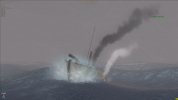Right, let's see...

Just a tiny query. I notice on the walkthrough that the model is grey for most of it. However, my model has been black throughout the process so far, despite at one point the walk-through said it shouldn't be anymore. Is this correct? I'm pretty sure I'm doing everything correctly...
If you check section 4.5 in the tutorial, it mentions turning on "Two Sided Lighting" in the viewport. That should display the model correctly if it came in looking black (i.e. with reversed normals).
However, this is only a temporary fix. When you change the render stats in section 5.1, the model will look black again. You have to reverse the normals as shown in section 5.2 to display the model properly.
Also, bear in mind this tutorial was written to address the issues you get when importing an OBJ file from GM Viewer, which is notorious for screwing everything up. It's possible that some of these steps don't apply to your model since you imported it in a different way. If you can send me the file you imported, I'll check it over and see what needs to be fixed when bringing it into Maya.
I also have a problem with the funnel; turning off two-sided has made it invisible from the inside, but of course I need it visible from outside too. Is there an easy fix for this or do I need to go back to C4D and add a second skin?

As that'll really up the tri count with the detail on the top...
Yeah, unfortunately you need to have distinct faces for both the inside and outside of any object you want to appear two-sided in-game.
I'm also having a fun time learning Maya's needlessly complicated materials system

In 100 clicks it feels like I did something I could've done in 1 click. But anyway, it won't let me 'Assign Material to Selection' in the normal way as the screen goes white whenever i click off it (that bug we mentioned before
@Armada ), meaning I can't select both the object and material at once so I need to do it using the hierarchy...but I guess that's more an inconvenience than a real issue.
This is perhaps the only area where I prefer 3ds Max to Maya.

The Slate editor in Max is much more intuitive, but Maya's system has been greatly improved with the 2016 releases, so I'd rank them fairly equally now.
As for Maya 5, you
can use Assign Material to Selection even if the viewport goes blank, so long as you haven't deselected the object. You can also hold the right mouse button over an object and go to Materials > Assign Existing Material in the context menu if you find that easier. OR you can middle-mouse-drag a material from the Hypershade window onto an object in the viewport if you're feeling adventurous.

I've also changed COPPER to weathered_copper in the GM file, so it looks a little tidier in the directory now.
Ah... one thing you need to know is that you can only swap textures between ships if those textures have the same number of characters in their name.
For example, if you wanted a ship to be able to use a weathered or non-weathered copper texture, the names could be "Copper1" and "Copper2" to keep things simple.
That said, it might be better to match the number of characters in "Plank_white", in which case your names could be "CopperTex_1" and "CopperTex_2".
Ok now I know how small she is...LOL...I don't get it though, as I followed the guides precisely to avoid this...

To fix, is it a simple matter of increasing the scale in Maya? I don't want to try without knowing as I'm scared of messing it up now I'm at this stage!
If you've set the working units to metres per section 4.3, make sure the model looks right on the grid. If necessary, make a 1x1x1 metre cube and compare its size to the ship just to check it by eye.
Then, make sure you use the correct export settings from section 7.5 (i.e. leave "0.01 Scale" UN-ticked).
Also concerned that I have the camera bug...probably because the flagpole is the same model. Do I need to split the models to fix that,
@Armada ?
Yes, you'll need to separate the mast and parent it to another locator to export it separately. Then, you need to add a Geometry locator to the hull model at the same coordinates.
It's easiest to keep the locator at (0,0,0), unless you want the object to behave like a mast, in which case you should call it "[ShipName]_mast1.gm" and place the locator at its base so it pivots correctly if it gets destroyed.
If you
don't want it to act like a mast and just want it to be static geometry, call it something like "[ShipName]_flagpole.gm" (anything other than "mast", "rey" or "path").
In
both cases, you must name the Geometry locator after the model suffix. If you go for "[ShipName]_mast1", the locator should just be called "mast1".















